Chengming Li
AutoCBT: An Autonomous Multi-agent Framework for Cognitive Behavioral Therapy in Psychological Counseling
Jan 16, 2025



Abstract:Traditional in-person psychological counseling remains primarily niche, often chosen by individuals with psychological issues, while online automated counseling offers a potential solution for those hesitant to seek help due to feelings of shame. Cognitive Behavioral Therapy (CBT) is an essential and widely used approach in psychological counseling. The advent of large language models (LLMs) and agent technology enables automatic CBT diagnosis and treatment. However, current LLM-based CBT systems use agents with a fixed structure, limiting their self-optimization capabilities, or providing hollow, unhelpful suggestions due to redundant response patterns. In this work, we utilize Quora-like and YiXinLi single-round consultation models to build a general agent framework that generates high-quality responses for single-turn psychological consultation scenarios. We use a bilingual dataset to evaluate the quality of single-response consultations generated by each framework. Then, we incorporate dynamic routing and supervisory mechanisms inspired by real psychological counseling to construct a CBT-oriented autonomous multi-agent framework, demonstrating its general applicability. Experimental results indicate that AutoCBT can provide higher-quality automated psychological counseling services.
UncertaintyRAG: Span-Level Uncertainty Enhanced Long-Context Modeling for Retrieval-Augmented Generation
Oct 03, 2024



Abstract:We present UncertaintyRAG, a novel approach for long-context Retrieval-Augmented Generation (RAG) that utilizes Signal-to-Noise Ratio (SNR)-based span uncertainty to estimate similarity between text chunks. This span uncertainty enhances model calibration, improving robustness and mitigating semantic inconsistencies introduced by random chunking. Leveraging this insight, we propose an efficient unsupervised learning technique to train the retrieval model, alongside an effective data sampling and scaling strategy. UncertaintyRAG outperforms baselines by 2.03% on LLaMA-2-7B, achieving state-of-the-art results while using only 4% of the training data compared to other advanced open-source retrieval models under distribution shift settings. Our method demonstrates strong calibration through span uncertainty, leading to improved generalization and robustness in long-context RAG tasks. Additionally, UncertaintyRAG provides a lightweight retrieval model that can be integrated into any large language model with varying context window lengths, without the need for fine-tuning, showcasing the flexibility of our approach.
PersonaMath: Enhancing Math Reasoning through Persona-Driven Data Augmentation
Oct 02, 2024



Abstract:While closed-source Large Language Models (LLMs) demonstrate strong mathematical problem-solving abilities, open-source models continue to struggle with such tasks. To bridge this gap, we propose a data augmentation approach and introduce PersonaMathQA, a dataset derived from MATH and GSM8K, on which we train the PersonaMath models. Our approach consists of two stages: the first stage is learning from Persona Diversification, and the second stage is learning from Reflection. In the first stage, we regenerate detailed chain-of-thought (CoT) solutions as instructions using a closed-source LLM and introduce a novel persona-driven data augmentation technique to enhance the dataset's quantity and diversity. In the second stage, we incorporate reflection to fully leverage more challenging and valuable questions. Evaluation of our PersonaMath models on MATH and GSM8K reveals that the PersonaMath-7B model (based on LLaMA-2-7B) achieves an accuracy of 24.2% on MATH and 68.7% on GSM8K, surpassing all baseline methods and achieving state-of-the-art performance. Notably, our dataset contains only 70.3K data points-merely 17.8% of MetaMathQA and 27% of MathInstruct-yet our model outperforms these baselines, demonstrating the high quality and diversity of our dataset, which enables more efficient model training. We open-source the PersonaMathQA dataset, PersonaMath models, and our code for public usage.
Training on the Benchmark Is Not All You Need
Sep 03, 2024



Abstract:The success of Large Language Models (LLMs) relies heavily on the huge amount of pre-training data learned in the pre-training phase. The opacity of the pre-training process and the training data causes the results of many benchmark tests to become unreliable. If any model has been trained on a benchmark test set, it can seriously hinder the health of the field. In order to automate and efficiently test the capabilities of large language models, numerous mainstream benchmarks adopt a multiple-choice format. As the swapping of the contents of multiple-choice options does not affect the meaning of the question itself, we propose a simple and effective data leakage detection method based on this property. Specifically, we shuffle the contents of the options in the data to generate the corresponding derived data sets, and then detect data leakage based on the model's log probability distribution over the derived data sets. If there is a maximum and outlier in the set of log probabilities, it indicates that the data is leaked. Our method is able to work under black-box conditions without access to model training data or weights, effectively identifying data leakage from benchmark test sets in model pre-training data, including both normal scenarios and complex scenarios where options may have been shuffled intentionally or unintentionally. Through experiments based on two LLMs and benchmark designs, we demonstrate the effectiveness of our method. In addition, we evaluate the degree of data leakage of 31 mainstream open-source LLMs on four benchmark datasets and give a ranking of the leaked LLMs for each benchmark, and we find that the Qwen family of LLMs has the highest degree of data leakage.
Fine-Tuning and Deploying Large Language Models Over Edges: Issues and Approaches
Aug 20, 2024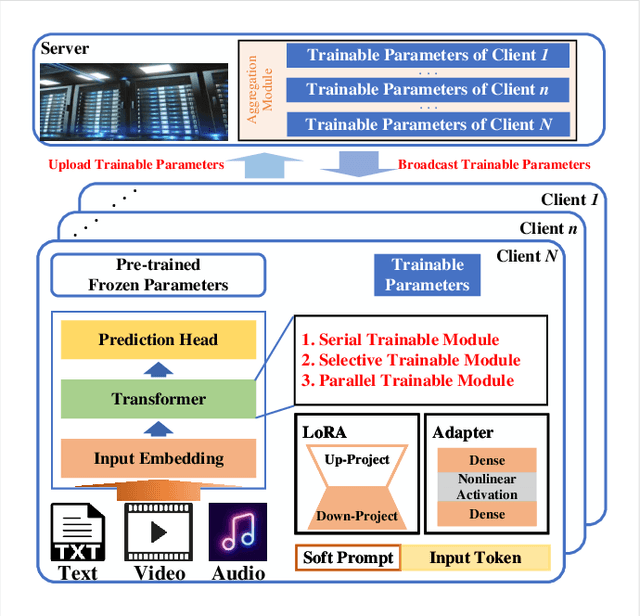

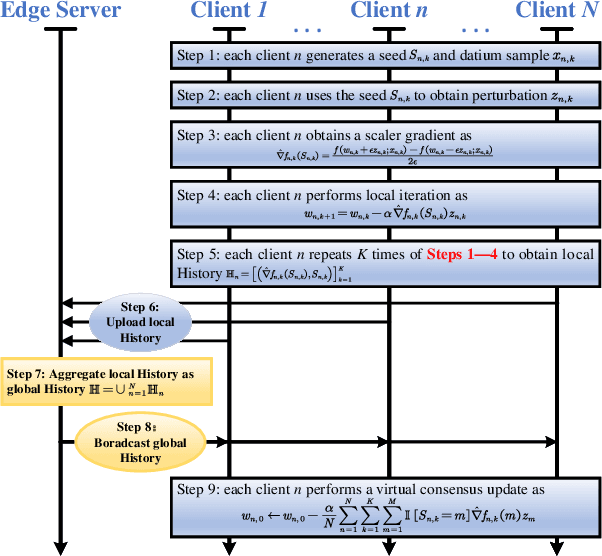
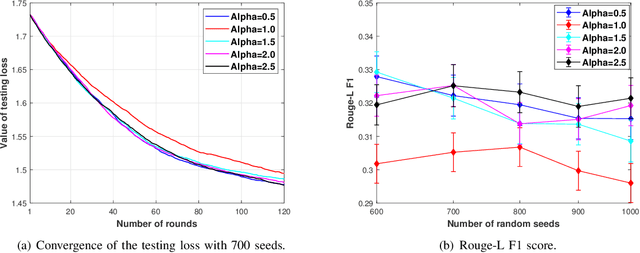
Abstract:Since the invention of GPT2--1.5B in 2019, large language models (LLMs) have transitioned from specialized models to versatile foundation models. The LLMs exhibit impressive zero-shot ability, however, require fine-tuning on local datasets and significant resources for deployment. Traditional fine-tuning techniques with the first-order optimizers require substantial GPU memory that exceeds mainstream hardware capability. Therefore, memory-efficient methods are motivated to be investigated. Model compression techniques can reduce energy consumption, operational costs, and environmental impact so that to support sustainable artificial intelligence advancements. Additionally, large-scale foundation models have expanded to create images, audio, videos, and multi-modal contents, further emphasizing the need for efficient deployment. Therefore, we are motivated to present a comprehensive overview of the prevalent memory-efficient fine-tuning methods over the network edge. We also review the state-of-the-art literatures on model compression to provide a vision on deploying LLMs over the network edge.
Lower Layer Matters: Alleviating Hallucination via Multi-Layer Fusion Contrastive Decoding with Truthfulness Refocused
Aug 16, 2024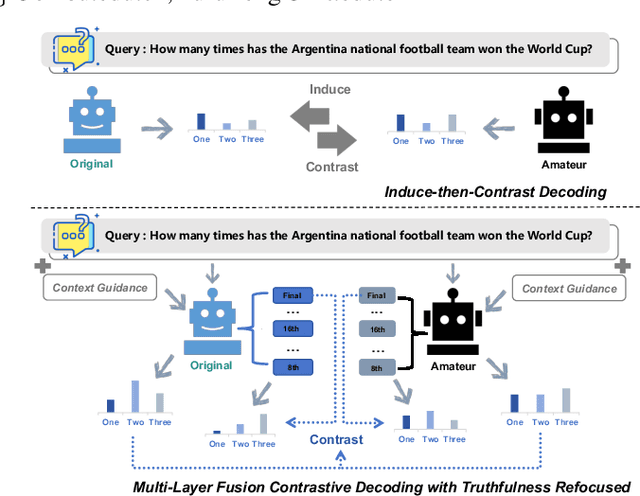
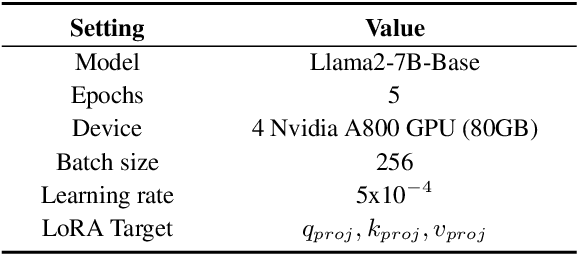
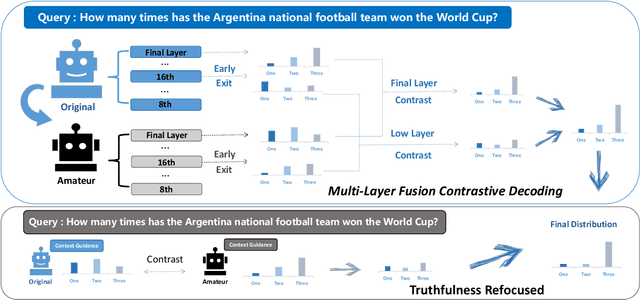
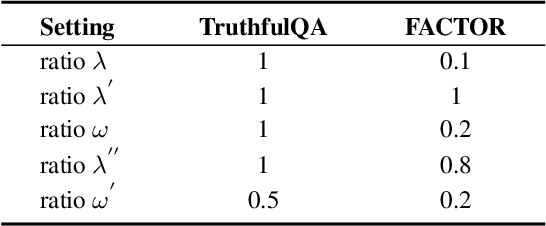
Abstract:Large Language Models (LLMs) have demonstrated exceptional performance across various natural language processing tasks, yet they occasionally tend to yield content that factually inaccurate or discordant with the expected output, a phenomenon empirically referred to as "hallucination". To tackle this issue, recent works have investigated contrastive decoding between the original model and an amateur model with induced hallucination, which has shown promising results. Nonetheless, this method may undermine the output distribution of the original LLM caused by its coarse contrast and simplistic subtraction operation, potentially leading to errors in certain cases. In this paper, we introduce a novel contrastive decoding framework termed LOL (LOwer Layer Matters). Our approach involves concatenating the contrastive decoding of both the final and lower layers between the original model and the amateur model, thereby achieving multi-layer fusion to aid in the mitigation of hallucination. Additionally, we incorporate a truthfulness refocused module that leverages contextual guidance to enhance factual encoding, further capturing truthfulness during contrastive decoding. Extensive experiments conducted on two publicly available datasets illustrate that our proposed LOL framework can substantially alleviate hallucination while surpassing existing baselines in most cases. Compared with the best baseline, we improve by average 4.5 points on all metrics of TruthfulQA. The source code is coming soon.
AgentCourt: Simulating Court with Adversarial Evolvable Lawyer Agents
Aug 15, 2024



Abstract:In this paper, we present a simulation system called AgentCourt that simulates the entire courtroom process. The judge, plaintiff's lawyer, defense lawyer, and other participants are autonomous agents driven by large language models (LLMs). Our core goal is to enable lawyer agents to learn how to argue a case, as well as improving their overall legal skills, through courtroom process simulation. To achieve this goal, we propose an adversarial evolutionary approach for the lawyer-agent. Since AgentCourt can simulate the occurrence and development of court hearings based on a knowledge base and LLM, the lawyer agents can continuously learn and accumulate experience from real court cases. The simulation experiments show that after two lawyer-agents have engaged in a thousand adversarial legal cases in AgentCourt (which can take a decade for real-world lawyers), compared to their pre-evolutionary state, the evolved lawyer agents exhibit consistent improvement in their ability to handle legal tasks. To enhance the credibility of our experimental results, we enlisted a panel of professional lawyers to evaluate our simulations. The evaluation indicates that the evolved lawyer agents exhibit notable advancements in responsiveness, as well as expertise and logical rigor. This work paves the way for advancing LLM-driven agent technology in legal scenarios. Code is available at https://github.com/relic-yuexi/AgentCourt.
APTNESS: Incorporating Appraisal Theory and Emotion Support Strategies for Empathetic Response Generation
Jul 23, 2024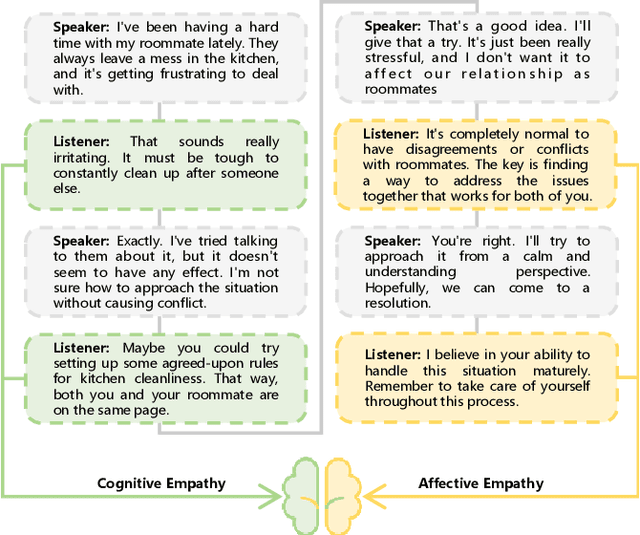

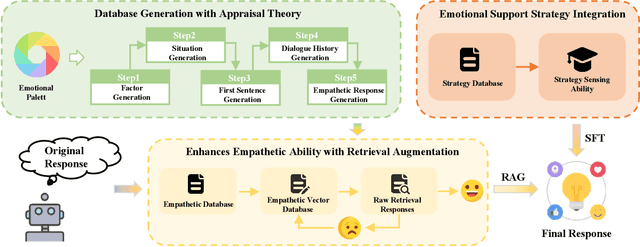
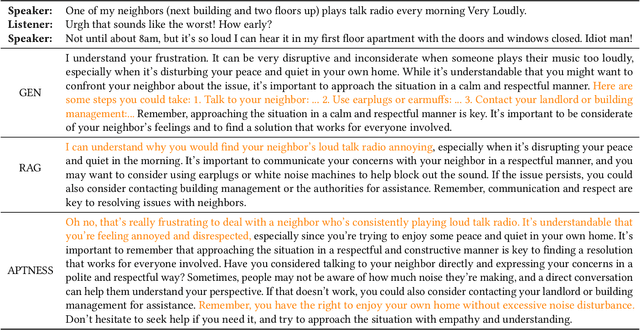
Abstract:Empathetic response generation is designed to comprehend the emotions of others and select the most appropriate strategies to assist them in resolving emotional challenges. Empathy can be categorized into cognitive empathy and affective empathy. The former pertains to the ability to understand and discern the emotional issues and situations of others, while the latter involves the capacity to provide comfort. To enhance one's empathetic abilities, it is essential to develop both these aspects. Therefore, we develop an innovative framework that combines retrieval augmentation and emotional support strategy integration. Our framework starts with the introduction of a comprehensive emotional palette for empathy. We then apply appraisal theory to decompose this palette and create a database of empathetic responses. This database serves as an external resource and enhances the LLM's empathy by integrating semantic retrieval mechanisms. Moreover, our framework places a strong emphasis on the proper articulation of response strategies. By incorporating emotional support strategies, we aim to enrich the model's capabilities in both cognitive and affective empathy, leading to a more nuanced and comprehensive empathetic response. Finally, we extract datasets ED and ET from the empathetic dialogue dataset \textsc{EmpatheticDialogues} and ExTES based on dialogue length. Experiments demonstrate that our framework can enhance the empathy ability of LLMs from both cognitive and affective empathy perspectives. Our code is released at https://github.com/CAS-SIAT-XinHai/APTNESS.
Resource Allocation and Workload Scheduling for Large-Scale Distributed Deep Learning: A Survey
Jun 12, 2024Abstract:With rapidly increasing distributed deep learning workloads in large-scale data centers, efficient distributed deep learning framework strategies for resource allocation and workload scheduling have become the key to high-performance deep learning. The large-scale environment with large volumes of datasets, models, and computational and communication resources raises various unique challenges for resource allocation and workload scheduling in distributed deep learning, such as scheduling complexity, resource and workload heterogeneity, and fault tolerance. To uncover these challenges and corresponding solutions, this survey reviews the literature, mainly from 2019 to 2024, on efficient resource allocation and workload scheduling strategies for large-scale distributed DL. We explore these strategies by focusing on various resource types, scheduling granularity levels, and performance goals during distributed training and inference processes. We highlight critical challenges for each topic and discuss key insights of existing technologies. To illustrate practical large-scale resource allocation and workload scheduling in real distributed deep learning scenarios, we use a case study of training large language models. This survey aims to encourage computer science, artificial intelligence, and communications researchers to understand recent advances and explore future research directions for efficient framework strategies for large-scale distributed deep learning.
II-Bench: An Image Implication Understanding Benchmark for Multimodal Large Language Models
Jun 11, 2024



Abstract:The rapid advancements in the development of multimodal large language models (MLLMs) have consistently led to new breakthroughs on various benchmarks. In response, numerous challenging and comprehensive benchmarks have been proposed to more accurately assess the capabilities of MLLMs. However, there is a dearth of exploration of the higher-order perceptual capabilities of MLLMs. To fill this gap, we propose the Image Implication understanding Benchmark, II-Bench, which aims to evaluate the model's higher-order perception of images. Through extensive experiments on II-Bench across multiple MLLMs, we have made significant findings. Initially, a substantial gap is observed between the performance of MLLMs and humans on II-Bench. The pinnacle accuracy of MLLMs attains 74.8%, whereas human accuracy averages 90%, peaking at an impressive 98%. Subsequently, MLLMs perform worse on abstract and complex images, suggesting limitations in their ability to understand high-level semantics and capture image details. Finally, it is observed that most models exhibit enhanced accuracy when image sentiment polarity hints are incorporated into the prompts. This observation underscores a notable deficiency in their inherent understanding of image sentiment. We believe that II-Bench will inspire the community to develop the next generation of MLLMs, advancing the journey towards expert artificial general intelligence (AGI). II-Bench is publicly available at https://huggingface.co/datasets/m-a-p/II-Bench.
 Add to Chrome
Add to Chrome Add to Firefox
Add to Firefox Add to Edge
Add to Edge